Body length: 11–30 mm.
Eyes: eye interommatidial setaeseta:
a sclerotized hair-like projection of the cuticle
present or absent, eye deeply emarginateemarginate:
notched at the margin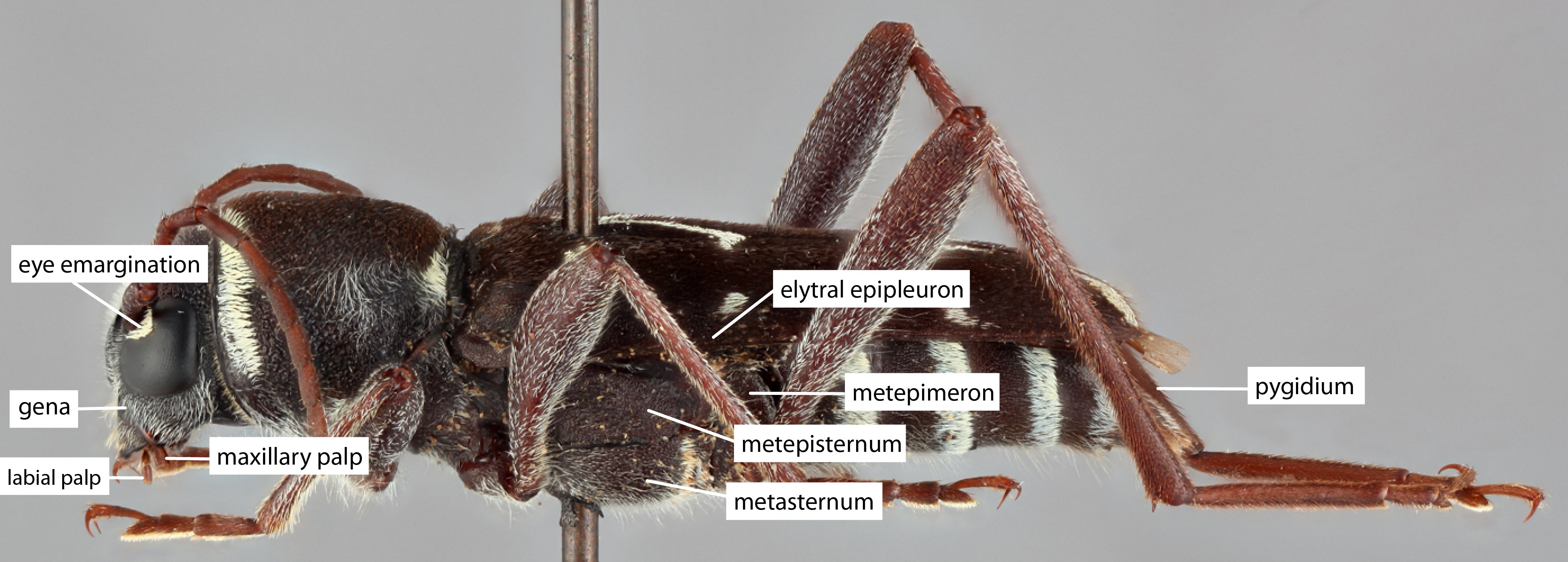 > half width, eye ommatidial density coarse.
> half width, eye ommatidial density coarse.
Antennaeantenna:
in larval and adult insects, paired segmented appendages, borne one on each side of the head, functioning as sense organs and bearing a large number of sensilla
: antennal length reaches between basebase:
the part of any appendage or structure that is nearest the body
and end of elytraelytron:
the leathery forewing of beetles, serving as a covering for the hind wings, commonly meeting opposite elytron in a straight line down the middle of the dorsum in repose
or reaching/surpassing end of body, antennal flagellar segments elongateelongate:
much longer than wide
, scapescape:
the first proximal segment of the antenna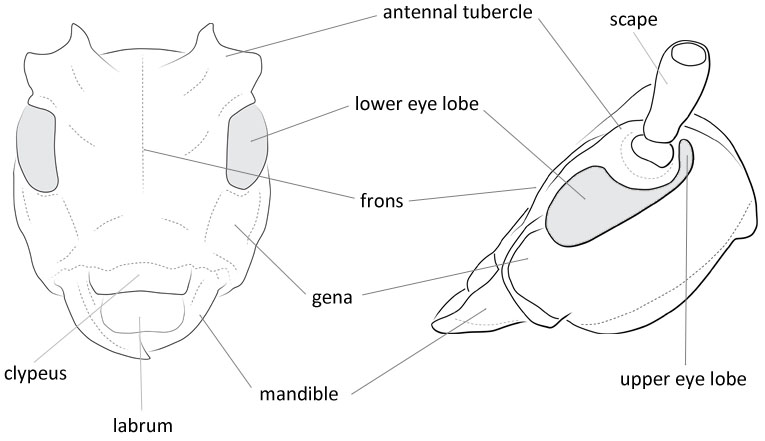 smooth/punctate at apexapex:
smooth/punctate at apexapex:
end of any structure distad to the base
, antennal segment 3 > scapescape:
the first proximal segment of the antenna .
.
Pronotumpronotum:
the upper and dorsal part of the prothorax
: pronotumpronotum:
the upper and dorsal part of the prothorax
shape transversetransverse:
broader than long
, pronotumpronotum:
the upper and dorsal part of the prothorax
lateral armature absent.
Prosternum: prosternal processprosternal process:
a posterior extension of the prosternum between the coxae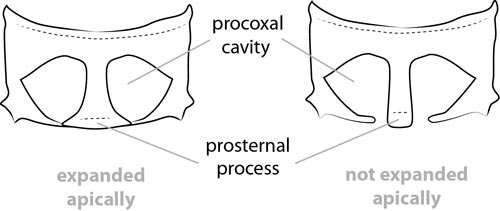 dilated at apexapex:
dilated at apexapex:
end of any structure distad to the base
, procoxal cavities open posteriorly.
Elytraelytron:
the leathery forewing of beetles, serving as a covering for the hind wings, commonly meeting opposite elytron in a straight line down the middle of the dorsum in repose
: elytral length reaching or close to end of abdomen, elytral apicesapex:
end of any structure distad to the base
emarginate or with tooth or spinespine:
a protuberance with an acute (sharp) distal end
, elytral color black, brown, yellow, reddish, or orange, elytral color pattern present or absent.
Legs: visible tarsomerestarsomere:
subdivision or article of the tarsus, usually numbering from two to five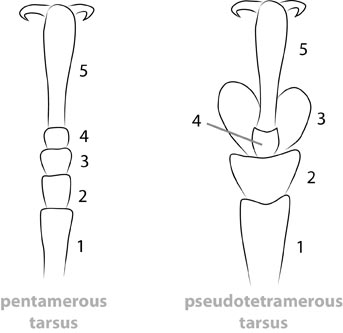 : 4, femora slender, protibial spursprotibial spur:
: 4, femora slender, protibial spursprotibial spur:
sclerotized spine(s) located at the distal tibia; can be single, double, or absent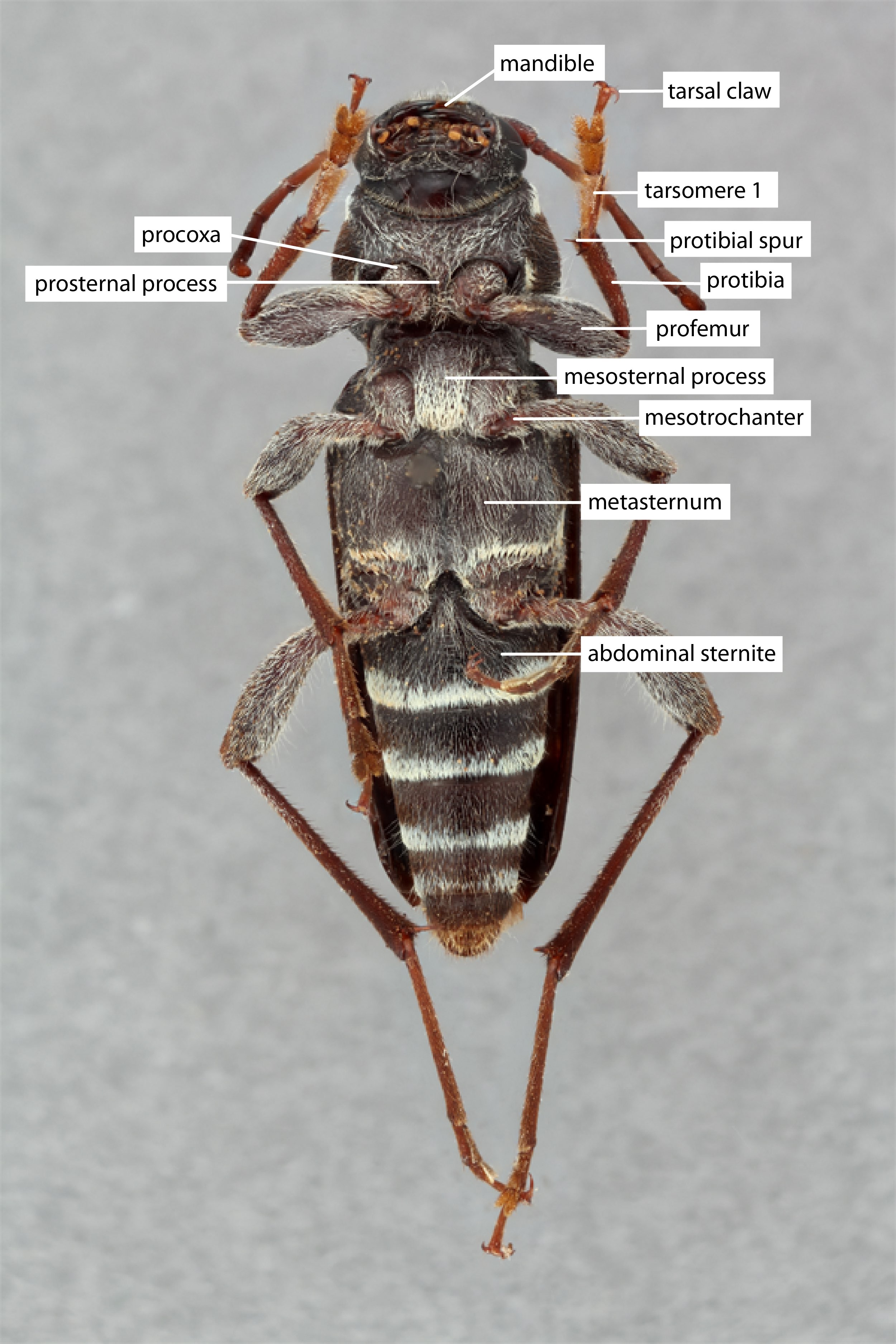 : 2, tarsal clawstarsal claw:
: 2, tarsal clawstarsal claw:
usually paired claws of the pretarsus, at the distal end of the leg simple.
simple.
Form moderate sized, slender to moderately robust. Antennaeantenna:
in larval and adult insects, paired segmented appendages, borne one on each side of the head, functioning as sense organs and bearing a large number of sensilla
prominently spined internally on third segment, less so on fourth and following segments, frequently with segments 3 and 4 bispinose, nearly always with some segments bispinose. Prosternum with intercoxal process nearly plane, truncatetruncate:
cut off squarely at the tip
or rounded behind, then abruptly, vertically or concavely declivous. Elytraelytron:
the leathery forewing of beetles, serving as a covering for the hind wings, commonly meeting opposite elytron in a straight line down the middle of the dorsum in repose
with a prominent external spinespine:
a protuberance with an acute (sharp) distal end
at apexapex:
end of any structure distad to the base
, usually also a spinespine:
a protuberance with an acute (sharp) distal end
at suturesuture:
groove marking the line of fusion of two formerly distinct plates; the line of junction of elytra
. Femora usually armed with apical spines (Linsley 1963Linsley 1963:
Linsley EG. 1963. The Cerambycidae of North America. Part IV. Taxonomy and Classification of the Subfamily Cerambycinae, Tribes Elaphidionini Through Rhinotragini. University of California Publications in Entomology, Vol. 21. 165 pp.).
Centrocerum, Enaphalodes, Anelaphus
"The large and primarily Caribbean genus Elaphidion is distinguished by the abruptly declivous prosternal processprosternal process:
a posterior extension of the prosternum between the coxae between the procoxaeprocoxa:
between the procoxaeprocoxa:
coxa of the front leg  (arcuately declivous in Anelaphus), the more pronounced mesal (and often apicolateral) spines on most antennomeresantennomere:
(arcuately declivous in Anelaphus), the more pronounced mesal (and often apicolateral) spines on most antennomeresantennomere:
a subunit of the antenna, including the scape, pedicel, and flagellomeres
—usually very strong mesally on antennomereantennomere:
a subunit of the antenna, including the scape, pedicel, and flagellomeres
3 (restricted to antennomeresantennomere:
a subunit of the antenna, including the scape, pedicel, and flagellomeres
3–6 or fewer in most species of Anelaphus), the bispinose elytral apicesapex:
end of any structure distad to the base
in most specimens (rounded apicolaterally in most Anelaphus), and the spinosespinose:
armed with thorny spines, more elongate than echinate
or dentiform metafemoral apicesapex:
end of any structure distad to the base
(rounded in Anelaphus)" (Lingafelter 2020Lingafelter 2020:
Lingafelter SW. 2020. Review of species of Anelaphus Linsley and its new synonym Gymnopsyra Linsley from the United States and Canada with description of a new species, synonymies, distributional notes and an illustrated identification key (Coleoptera: Cerambycidae: Elaphidiin. Insecta Mundi 798: 1–30.).
Neotropical, Nearctic
broadleaf trees
60 species
Cycliopleurus Hope, 1835
Elaphidium Agassiz, 1846
Hypermallus Bates, 1880
Elaphidion Audinett-Serville, 1834